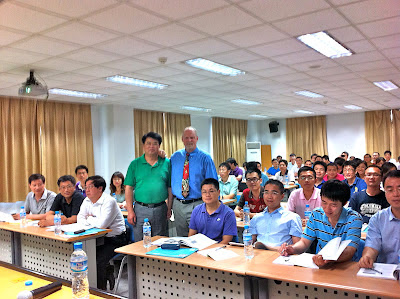Tokyo as a wonderful visit and DISC with 53 in attendance. This is the 19th DISC and brings the total 2012 DISC attendance to 955. And we still have several stops to go later in the year.
My contact was the very able organizer Hideki Saito of OYO and SEGJ. It was very nice to see recent University of Houston PhD grad Ayato Kato and Prof. Hitoshi Mikada of Kyoto University (very cool web page for geophysics). I learned from Hitoshi that the work load of Japanese professors is immense... he advises 14 graduate students, teaches 6 courses per year (up to 200/class in some of them and no teaching assistant to help grade), and he maintains an active funded research program. I will never again complain about the life of a US professor.
The venue was a great presentation room at AIST near my hotel in the la Daiba area. Like all of Tokyo, this is an area of amazing engineering: An auto tunnel under the ocean bay right outside my hotel window. a bridge with roadway on top, trucks and train on lower deck, and a building that looks like a Menger sponge with a sphere attached. Crazy and beautiful. Oh, and it all works.
After the class, my host, the professor and some students of his took me out for a few beers. We sat outside overlooking the harbor as night fell on Tokyo. A beautiful evening with good company and a world-class view. Thanks to all.
Tokyo DISC 2012
Recent UH graduate Dr. Ayato Kato
Evening beers with Prof. Mikada (far back left), Hideki Saito (far back right), and students.
A grand view
The Menger sponge building with sphere as seen from the beach.
A side trip to Kamakura found many beautiful things.
Our trusty mascot Niffy takes in a final breathtaking view of Tokyo before heading home.
















































